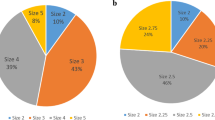Abstract
Several urogynecologic syndromes are associated with the clinical finding of a short, painful, tender and weak pelvic floor and a variety of connective tissue abnormalities. Techniques for rehabilitation include the avoidance of perpetuating factors, rehabilitation of extrapelvic musculoskeletal abnormalities, the use of manual techniques and needling to promote resolution of connective tissue problems, closure of any diastasis recti, and transvaginal/transrectal manual release of muscular trigger points and contractures. Therapy can be facilitated by pudendal or epidural nerve block. Patients contribute to their success through home maintenance programs.






Similar content being viewed by others
Abbreviations
- TP:
-
Trigger point
- PFM:
-
Pelvic floor muscles
References
FitzGerald MP, Brubaker L, Kotarinos R. Rehabiliation of the short pelvic floor. I: Background, patient evaluation. (In press)
Cantu RI, Grodin AJ (1992) Myofascial manipulation. Theory and Clinical Application. Aspen Publishers
Greenman PE (1996) Principle of manual medicine. Lippincott Williams & Wilkins, Philadelphia
Travell J, Simons D (1992) The trigger point manual, vol 2. Williams & Wilkins, Baltimore
Kuchera ML, Kuchera WA (1992) Osteopathic considerations in systemic dysfunction, 2nd edn. KCOM Press, Kirskville, MO
Helms JM (1995) Acupuncture energetics. A clinical approach for physicians. Medical Acupuncture Publishers, Berkeley, CA
Basmijian JV (1967) Muscles alive. Their functions revealed by electromyography. Williams & Wilkins, Baltimore
Floyd WF, Silver PHS (1950) Electromyographic study of patterns of activity of the anterior wall muscles in man. J Anat 84:132–145
Hatami J (1961) Electromyographic studies of the influence of pregnancy on activity of the abdominal muscles. Tohoku J Exp Med 75:71–88
Kendall HO, Kendall FP, Boyton D (1977) Posture and pain. Baltimore, Williams & Wilkins
Kendall FP, McCreary EK, Provance PG (1993) Muscle testing and function. Williams & Wilkins, Baltimore
Lewit K (1986) Post-isometric relaxation in combination with other methods of muscular facilitation and inhibition. Manual Med 2:101–104
Sherrington C (1961) The integrative action of the nervous system. Yale University Press, New Haven, CT
Knott M, Voss D (1968) Proprioceptive neuromuscular facilitation, 2nd edn. Harper & Row, New York
Mense S, Simons DG (2001) Muscle pain. Understanding its nature, diagnosis and treatment. Lippincott Williams & Wilkins, Philadelphia
Travell J, Simons D (1983) The trigger point manual, vol 1. Williams & Wilkins, Baltimore
O'Leary MP, Sant GR, Fowler FJ, Whitmore KE, Spolarich-Kroll J (1997) The interstitial cystitis symptom index and problem index. Urology 49 [Suppl 5A]:58–63
Acknowledgement
Illustrations by Dr. M.J.T. FitzGerald.
Author information
Authors and Affiliations
Corresponding author
Additional information
Editorial Comment: The authors nicely describe a syndrome called short pelvic floor syndrome. Healthcare providers who treat and diagnose conditions of the female pelvic floor should be aware of and versed in both the diagnosis and the treatment of conditions that can cause pelvic pain. To date this area has been poorly understood and very poorly studied. Hopefully preliminary data such as these will stimulate more collaboration between clinicians and physical therapy specialists, so that these very difficult patients can be better served.
Rights and permissions
About this article
Cite this article
FitzGerald, M.P., Kotarinos, R. Rehabilitation of the short pelvic floor. II: Treatment of the patient with the short pelvic floor. Int Urogynecol J 14, 269–275 (2003). https://doi.org/10.1007/s00192-003-1050-7
Received:
Accepted:
Published:
Issue Date:
DOI: https://doi.org/10.1007/s00192-003-1050-7




